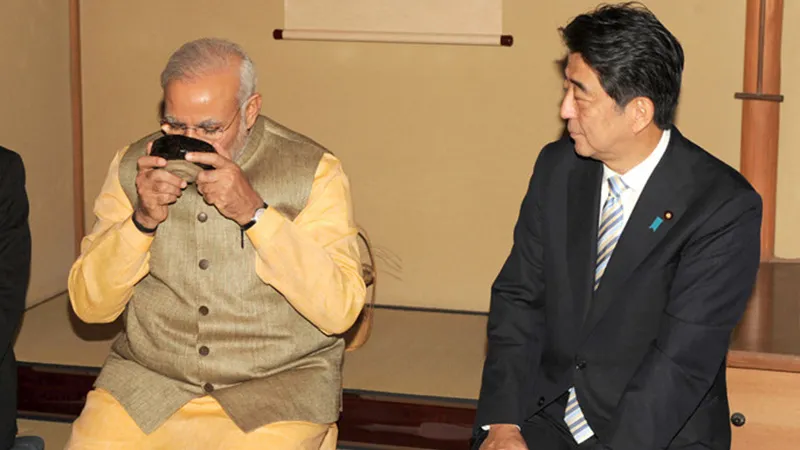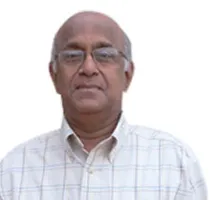-
CENTRES
Progammes & Centres
Location
Modi and Abe will be holding their third summit and second one to be held in Tokyo in a bid to renew their special strategic and global partnership

Indian Prime Minister Narendra Modi is travelling to Tokyo for yet another annual summit with Japanese Prime Minister Shinzo Abe on November 11 & 12. This is the third summit between the two leaders and the second one to be held in Tokyo. Given that the two leaders enjoy a close personal chemistry bodes well for the partnership to gain further momentum from the meeting. The last two summits saw India and Japan carrying forward their relations to new levels. For instance, following their 2014 summit meeting, both Modi and Abe issued the Tokyo Declaration which called the partnership a “special strategic and global partnership” heralding the dawn of a new era. In 2015, the summit met in New Delhi and issued the India-Japan Vision 2025 that talked about an action oriented partnership.
Considering that the partnership has been buttressed by a vast institutional network and has enjoyed a great degree of continuity despite political changes, there is no doubt that the upcoming summit will become one more significant milestone in the rapidly expanding bilateral interactions.
Relations between the two until very recently were narrowly focused on economic matters such as development assistance, trade and investment; but now they have diversified across a wide range of interests, including regional cooperation, maritime security, counter terrorism, nuclear disarmament, U.N. reforms, climate change and energy cooperation. Both countries have steadily maintained the momentum of their relations since the last summit meeting. Both Modi and Abe had met a few times on the sidelines of some regional and global forums to carry forward their dialogue. The defence minister of Japan, Gen Nakatani, visited India in July this year and discussed the prospects of expanded cooperation in the defence sphere. Japan has become a regular participant in the Malabar exercises. Follow-up talks on the high speed railway system between Mumbai and Ahmadabad have been going on satisfactorily.
There is a great deal of expectation in India that during the current summit meeting, both countries will finally settle satisfactorily the two most important issues that have been hanging fire for many years. The first one relates to the conclusion of the agreement on civil nuclear cooperation. As is well-known, the initial efforts for the agreement were started in 2010 itself, but subsequently, the Fukushima disaster of 2011 put a spoke on the progress of the negotiations. It was only after 2013 that the two countries resumed their talks. Finally, in December 2015, both Abe and Modi agreed in principle to sign the agreement after finalising the technical details, including those related to the necessary internal procedures like parliamentary approval.
Now it is almost one year since the New Delhi summit and there are some positive reports on the prospects of the agreement being signed in view of Prime Minister Abe’s present strong political strength and his willingness to exercise it. But given the fact that Japan will sign a civil nuclear agreement for the first time with a non-signatory to the NPT, makes Abe navigate the issue carefully, giving due consideration to the strong domestic antipathy to nuclear energy. All 50 nuclear reactors in Japan except one are non-functional and their resumption faces strong popular resistance. Though Abe‘s new national energy policy has assigned a key role to the nuclear power, he is not in a position to determine its share in the overall electricity production. His quest to restore the importance of nuclear power to the pre-Fukushima years still remains a distant dream.
There are reports that the Abe government is still inclined to insist on the inclusion of a nullification clause in the agreement that would state that if India decided to conduct a nuclear test in future, Japan would have the option to terminate the agreement. India for its part emphasises its own strong commitment to non-proliferation goals and argues that the assurances that it gave to the US at the time of signing the US-India nuclear agreement in 2008 are sufficient for the present bilateral agreement too. In addition, India believes that it has enhanced its transparency in its nuclear infrastructure by ratifying the additional protocol with the IAEA in 2014.
The proposed civil nuclear agreement between India and Japan has positive points for both countries. First, at a time when India is seriously pursuing its admission to the Nuclear Suppliers Group, the agreement would send a message of trust to the members of the Group. Second, the agreement would ensure the availability of many key Japanese nuclear technologies to India. Further, unless the two countries sign an agreement, India will not be able to enjoy the benefits of its earlier agreement with the US. American companies like the Westinghouse and General Electric are virtually owned by Japanese giants like Toshiba and Hitachi and they will not be able to set up their reactors in India without an agreement between India and Japan. Purely from a commercial angle, Japan will stand to benefit a great deal by promoting cooperation with India. In the coming decades, India will need to promote clean energy as part of its development strategy and Japan will be a useful partner in setting up its advanced nuclear plants in India. Of course, as the partnership progresses, both countries will have to address issues such as India’s reprocessing needs, nuclear liability issues, etc.
Many of the points discussed above are well-known and yet one can see an air of optimism in the atmosphere. The growing strategic convergences between the two courtiers and the mutual benefits they would gain from the agreement could drive them to hammer out a settlement. Such an agreement would have the additional advantage of further deepening their relations with the US. Many well-informed analysts believe that both countries will ultimately use their wisdom to strike a practical balance between their energy needs and non-proliferation goals.
The second issue that needs to be settled pertains to the sale of Japan’s indigenously manufactured US-2 amphibious aircraft. Both countries have been conducting talks for well over two years. Defence cooperation is one area which offers numerous opportunities for closer partnership. That Abe has relaxed Japan’s export policy on defence technologies is an additional factor favouring closer partnership between the two countries. When Japan’s defence minister Gen Nakatani visited India in July 2016 he emphasised that a strong India-Japan strategic partnership would depend on deep and broad-based cooperation in defence and security spheres.
The India-Japan deal on the US2 amphibious aircraft has been dragging on due to differences on issues like pricing, mode of purchase and technology transfer. Considering their own convergent security interests in the Asia-Pacific region, there is a strong realisation in both countries to push through the deal during the present summit. There are reports that they would sign a memorandum of understanding on the deal and later implement it after fulfilling the necessary formalities.
There are many other areas such as maritime security, cooperation in the modernisation of India’s railways system, connectivity projects, etc, where the two leaders will seek to lay out a roadmap for deepening the partnership. On the whole, the forthcoming Tokyo summit will be one more important milestone in the rapidly unfolding partnership.
The views expressed above belong to the author(s). ORF research and analyses now available on Telegram! Click here to access our curated content — blogs, longforms and interviews.

K.V. Kesavan (1938 2021) was Visiting Distinguished Fellow at ORF. He was one of the leading Indian scholars in the field of Japanese studies. Professor ...
Read More +